问题13:两个相似的三角形的周长分别为25厘米和15厘米。如果第一个三角形的一侧是9厘米,那么另一个三角形的对应侧是什么?
解决方案:

Given: perimeter of two similar triangles are 25 cm, 15 cm and one side 9 cm
To find : the other side.
Let the two triangles be ABC & PQR.
Let one of its side is (AB) = 9 cm and the other side of other triangle be PQ.
∆ABC ∼ ∆PQR. [Since the ratio of corresponding sides of similar triangles is same as the ratio of their perimeters.]
AB/PQ = BC/QR = AC/PR = 25/15
9/PQ = 25/15
25 PQ = 15 × 9
PQ = (15×9)/25
PQ =(3× 9 )/5
PQ = 27/5
PQ = 5.4 cm
Hence, the corresponding side of other ∆ is 5.4 cm.
问题14.在ΔABC和ΔDEF中,假设AB = 5 cm,BC = 4 cm,CA = 4.2 cm,DE = 10 cm,EF = 8 cm,FD = 8.4 cm。如果AL⊥BC,DM⊥EF,则找到AL:Dm。
解决方案:

Given,
AB = 5 cm, BC = 4 cm, CA = 4.2 cm, DE = 10 cm, EF = 8 cm, and FD = 8.4 cm
AL ⊥ BC, DM ⊥ EF
To find: AL: DM
Now In ∆ABC and ∆DEF,
AB/DE=BC/EF=AC/DF=1/2 [both triangles are similar]
[In similar triangle the ratio of corresponding altitude is same as the ratio of the corresponding sides.]
![]() AL: DM = 1: 2
AL: DM = 1: 2
问题15. D和E分别是ΔABC的AB和AC侧的点,使得AD = 8 cm,DB = 12 cm,AE = 6 cm和CE = 9 cm。证明BC = 5/2 DE。
解决方案:

AE/EC=6/9=2/3…….(1)
AD/DB=8/12=2/3……(2)
from (1) and (2) we know that
![]() AD/DB=AE/EC
AD/DB=AE/EC
![]() ED∥CB
ED∥CB
Now In△AED and △ACB,
ED∥CB
∠AED=∠ACB
∠ADE=∠ABC
△AED∼△ACB [by AAA criteria]
![]() AE/AC=ED//CB
AE/AC=ED//CB
AE/EC+AE= ED/CB [![]() AC=AE+EC]
AC=AE+EC]
6/6+9= ED/CB
6/15=2/5=ED/CB
![]() CB=5/2ED
CB=5/2ED
Hence proved
问题16. D是ΔABC边BC的中点。 AD在E点被一分为二,生成的BE在X点被切掉AC。证明BE:EX = 3:1
解决方案:

Given: In ∆ABC, D is the midpoint of BC, E is the midpoint of AD. BE produced meets AC at X.
To prove : BE: EX = 3 : 1
Now In Δ BCX and ΔDCY,
∠CBX = ΔCBY (corresponding angles)
∠CXB = ΔCYD (corresponding angles)
![]() ΔBCX∼ΔDCY (AA similarity)
ΔBCX∼ΔDCY (AA similarity)
![]() BC/DC = BX/ DY = CX/CY [ corresponding sides of two similar triangles are proportional]
BC/DC = BX/ DY = CX/CY [ corresponding sides of two similar triangles are proportional]
BX/DY = BC/DC
BX/DY = 2DC/DC [As D is the midpoint of BC]
BX/DY = 2/1…………(i)
Now In ΔAEX and ΔADY,
∠AEX = ΔADY (corresponding angles)
∠AXE = ΔAYD (corresponding angles)
![]() ΔAEX ∼ ΔADY (AA similarity)
ΔAEX ∼ ΔADY (AA similarity)
![]() AE/AD = EX/DY = AX/AY [ corresponding sides of two similar triangles are proportional]
AE/AD = EX/DY = AX/AY [ corresponding sides of two similar triangles are proportional]
EX/DY = AE/AD
EX/DY = AE/2AE [ D is the midpoint of BC]
EX/DY = ½…………..…(ii)
On Dividing eqn. (i) by eqn. (ii) we get,
BX/EX = 4/1
BX = 4EX
BE + EX = 4EX
BE = 4EX – EX
BE = 3EX
BE /EX = 3/1
BE : EX = 3:1
Hence proved
问题17. ABCD是平行四边形,APQ是在P处与BC在Q处相交的直线。证明BP和DQ所获得的矩形等于AB和BC所包含的矩形。
解决方案:

Given : ABCD is a parallelogram and APQ is a straight line meeting BC at P and DC produced at Q.
To prove : BP x DQ = AB x BC
Now In ∆ABP and ∆QDA,
∠B = ∠D [Opposite angles of parallelogram]
∠BAP = ∠AQD [Alternate interior angles]
![]() ∆ABP ~ ∆QDA [By AA similarity]
∆ABP ~ ∆QDA [By AA similarity]
![]() AB/QD = BP/DA [the corresponding sides of similar triangles are proportional]
AB/QD = BP/DA [the corresponding sides of similar triangles are proportional]
DA = BC [opposite sides of a parallelogram are equal]
AB/QD = BP/BC
AB × BC = QD × BP
Hence proved
问题18:在ΔABC中,AL和CM是从顶点A和C到BC和AB的垂线。如果Al和CM在O相交,则证明:
(i)ΔOMA〜ΔOLC
(ii)OA / OC = OM / OL
解决方案:

Given,
AL ⊥ BC and CM ⊥ AB
To prove:
(i) ΔOMA ∼ ΔOLC
(ii)OA/OC=OM/OL
Now In Δ OMA and ΔOLC,
∠MOA = ∠LOC [Vertically opposite angles]
∠AMO = ∠CLO [Each 90°]
![]() ΔOMA ~ ΔOLC [By AA similarity]
ΔOMA ~ ΔOLC [By AA similarity]
![]() OA/OC=OM/OL [Corresponding parts of similar Δ are proportional]
OA/OC=OM/OL [Corresponding parts of similar Δ are proportional]
Hence proved
问题19. ABCD是四边形,其中AD = BC。如果P,Q,R,S是AB,AC,CD和BD方面的中点。证明PQRS是菱形。
解决方案:

Given,
ABCD is a quadrilateral in which AD = BC and P, Q, R, S are the mid points of AB, AC, CD, BD, respectively.
To prove: PQRS is a rhombus
Now,
In ΔABC, P and Q are the mid points of the sides B and AC respectively
PQ ∥ BC and PQ = 1/2 BC. [By the midpoint theorem]
In ΔADC, Q and R are the mid points of the sides AC and DC respectively
By the mid-point theorem, we get,
QR ∥ AD QR = 1/2 AD [By the mid-point theorem]
![]() QR = 1/2 BC [AD = BC]
QR = 1/2 BC [AD = BC]
Now In ΔBCD,
RS∥BC and RS = 1/2 AD [By the mid-point theorem]
RS= 1/2 BC [AD = BC]
From above eqns.
PQ = QR = RS
![]() PQRS is a rhombus.
PQRS is a rhombus.
Hence proved
问题20.在等腰ΔABC中,基极AB会同时向P和Q方向生成,使得AP x BQ = AC2。证明ΔAPC〜ΔBCQ
解决方案:
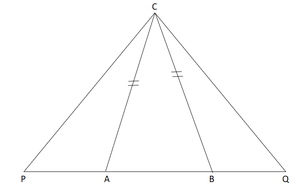
Given : ΔABC is isosceles ∆ and AP x BQ = AC²
To prove : ΔAPC∼ΔBCQ.
we know that,
ΔABC is an isosceles triangle AC = BC.
AP x BQ = AC² (given)
AP x BQ = AC x AC
AP x BQ = AC x BC
AP/BC = ABQ……….(1).
so, ∠CAB = ∠CBA [as AC = BC]
180° – ∠CAP = 180° – ∠CBQ [angles opposite to equal sides are EQUAL]
∠CAP = ∠CBQ ………..(2)
In ∆APC and ΔBCQ
AP/BC = AC/BQ [From equation 1]
∠CAP = ∠CBQ [From equation 2]
![]() ΔAPC∼ΔBCQ [By SAS similarity criterion]
ΔAPC∼ΔBCQ [By SAS similarity criterion]
Hence proved
问题21.一个身高90厘米的女孩以1.2 m / sec的速度从灯柱的底部走开。如果灯在离地面3.6m的高度,请在4秒钟后找到其阴影的长度。
解决方案:
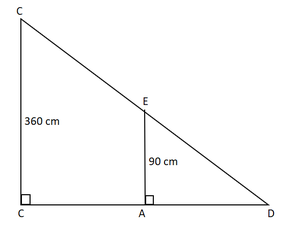
AD=1.2 m/sec ×4 sec =4.8 m =480 cm
Suppose the length of the shadow of the girl be x cm when she at position D. Therefore,
BD = x cm
In ∆BDE and ∆BAC,
∠BDE=∠BAC [each90°]
∠DBE=∠ABC [Common angle ]
![]() ∆BDE∼∆BAC [ by AA similarity]
∆BDE∼∆BAC [ by AA similarity]
BE/BC=DE/AC=BD/AB [Corresponding sides are proportional]
90/360=x/480+x
1/4= x/480+x
4x=480+x
4x−x=480
3x=480
x=480/3=160
Hence, the length of her shadow after 4 seconds is 160 cm.
问题22:一根长度为6 m的竖杆在地面上投射出一个长4m的阴影,同时,一个塔架则投射出一个长28m的阴影。找到塔的高度。
解决方案:
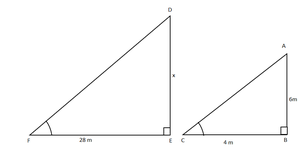
Let AB be stick and DE be tower.
A 6 m long stick casts a shadow of 4 m
So, AB = 6 m and BC = 4 m
Let DE casts shadow at the same time, So EF = 28 m
Let height of tower DE = x
Now in ∆ABC and ∆DEF,
∠B = ∠E (each 90°)
∠C = ∠F (shadows at the same time)
∆ABC ~ ∆DEF [AA criterion]
AB/DE=BC/EF [ Corresponding sides are proportional ]
![]() 6/x=4/28
6/x=4/28
x=42 m
Hence height of tower is 42 m
问题23。给定, ΔABC是C和DE C AB处的直角三角形。求证:ABCΔΔ〜ADE。因此找到AE和DE的长度。
解决方案:
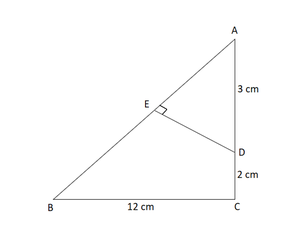
Given : ΔACB is right-angled triangle at C = 90°.
According to the figure : BC = 12 cm , AD=3 cm, DC = 2 cm.
AC = AD + DC = 3 +2= 5 cm
Now In ∆ACB,
AB² = AC² + BC² [by Pythagoras theorem]
AB² = 5² + 12²
AB² = 25 + 144 = 169
AB= √169 = 13
![]() AB = 13 cm
AB = 13 cm
Now In ΔABC & ΔADE,
∠BAC = ∠DAE [common]
∠ACB = ∠AED [each 90°]
![]() ΔABC∼ΔADE [by AA similarity criterion]
ΔABC∼ΔADE [by AA similarity criterion]
![]() AB/AD = BC/DE = AC/AE [ corresponding sides of two similar triangles are proportional]
AB/AD = BC/DE = AC/AE [ corresponding sides of two similar triangles are proportional]
13/3 = 12/ DE = 5/AE
13/3 = 12/DE
13 DE = 12×3
DE = 36/13
13/3 = 5/AE
13 AE = 5×3
AE = 15/13
Hence, the length of DE= 36/13 & AE = 15/13
问题24.在图中,PA,QB和RC分别垂直于AC。证明1 / X + 1 / Z = 1 / Y
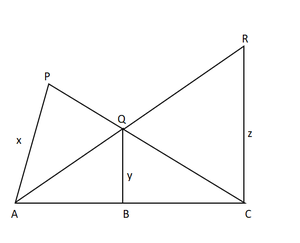
Given:
PA, QB and RC are each perpendicular to AC
To prove : 1/X+1/Z=1/Y
Now In ΔPAC and ΔQBC,
∠PCA = ∠QCB [common angle]
∠PAC = ∠QBC [Coresponding angles]
![]() ΔPAC ~ ΔQBC [by AA criteria]
ΔPAC ~ ΔQBC [by AA criteria]
![]() PA/QB = AC/BC [ Corresponding parts of similar triangles are proportional]
PA/QB = AC/BC [ Corresponding parts of similar triangles are proportional]
x/y = AB/BC
y/x = BC/AC
Now In ΔRCA and ΔQBA,
∠RAC = ∠QAB [common angle]
∠RCA = ∠QBA [Coresponding angle]
![]() ΔRCA ~ΔQBA [by AA criteria]
ΔRCA ~ΔQBA [by AA criteria]
![]() RC/QB = AC/AB [ Corresponding parts of similar triangles are proportional]
RC/QB = AC/AB [ Corresponding parts of similar triangles are proportional]
z/y= AC/AB
y/z= AB/AC
y/z + y/z = BC + AC/ AC = 1 [by adding both eq we get]
y/z + y/z = 1
1/x + 1/z = 1/y [multiplying both sides by y]
Hence proved
问题25。给定,我们有AB∥CD∥EF。如果AB = 6厘米,CD = x厘米,EF = 10厘米,BD = 4厘米,DE = y厘米。计算x和y的值。
解决方案:
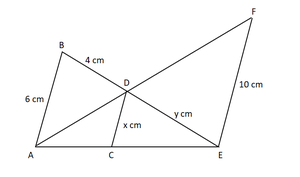
Given : AB || CD || EF , AB = 6 cm, CD = x cm, BD = 4 cm, and DE = y cm and EF = 10 cm.
Now In ∆ECD and ∆EAB,
∠CED = ∠AEB [common]
∠ECD = ∠EAB [corresponding angles]
![]() ∆ECD ~ ∆EAB ……….(1) [By AA similarity]
∆ECD ~ ∆EAB ……….(1) [By AA similarity]
∴ EC/EA = CD/AB [Corresponding parts of similar triangles are proportional]
EC / EA = x/6 ……………(2)
In ∆ACD and ∆AEF
∠CAD = ∠EAF [common]
∠ACD = ∠AEF [corresponding angles]
∆ACD ~ ∆AEF [By AA similarity]
∴ AC/AE = CD/EF [Corresponding parts of similar triangles are proportional]
AC /AE = x/10 ……………..(3)
EC/EA+ AC /AE = x/6 + x/10 [by Adding eq 2 & 3]
(EC + AC) /AE =( 5x + 3x)/30
AE / AE = 8x /30
1 = 8x/30
x = 30/8
x = 3.75 cm
∆ECD ~ ∆EAB [From eq (i)]
DC/AB = ED /EB [Corresponding parts of similar triangle are proportional]
3.75/6 = y/y+4
6y = 3.75(y+4)
6y = 3.75y + 15
6y – 3.75y = 15
2.25y = 15
y = 15/2.25
y = 6.67 cm
Hence, x = 3.75 cm and y = 6.67 cm.